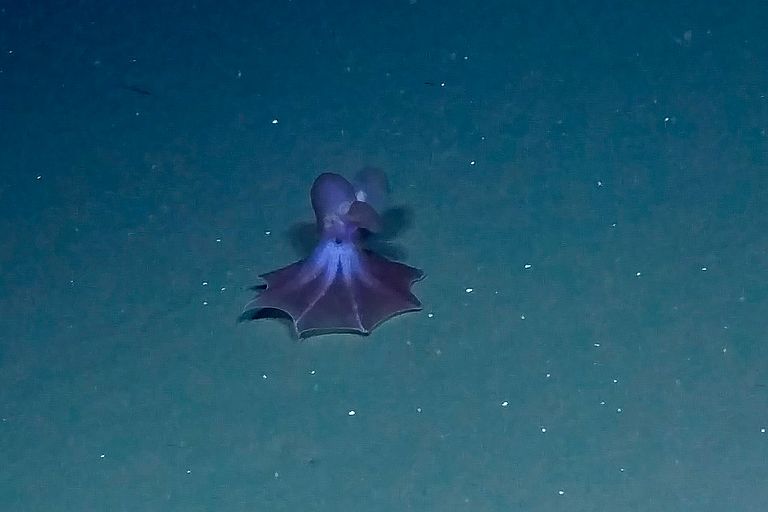Miles down for lunch
Deep-sea imagery and observations reveal novel octopus feeding behaviour
In the marine realm, diel vertical migration is a common feeding pattern: During daytime, zooplankton, fish and other marine life that feeds on these organisms hide in the darker depths of the ocean. At night, when there is less light, they rise to the surface to hunt for prey. Researchers from GEOMAR Helmholtz Centre for Ocean Research Kiel, Senckenberg am Meer – German Centre for Marine Biodiversity Research, Alfred Wegener Institute, Helmholtz Centre for Polar and Marine Research (AWI) (all Germany) and REV Ocean (Norway) observed octopuses in the Arctic taking the opposite route: Videos recorded with remotely operated vehicles and towed in-situ observation systems in the Arctic suggests that the “dumbo” octopus Cirrotheutis muelleri migrates from the water column to the sea floor, where it catches crustaceans and polychaetes.
“It is the first time, images of Cirrotheutis muelleri octopuses have been analysed in such detail”, emphasises Dr. Alexey Golikov. The deep-sea biologist at GEOMAR Helmholtz Centre for Ocean Research Kiel is lead author of the recent publication in the scientific journal Proceedings of the Royal Society B that describes the newly-observed octopus behaviour. “On the one hand, we saw these animals drifting freely in various depths of the water column with their arms and web spread out widely, in an umbrella-like posture – a very energy-efficient and stealthy way to roam their environment. But then there was this very distinct feeding pattern: Using their wing-like fins, they swim slowly above the sea floor, suddenly land to envelop their food with their arms and web and take off with their meal, flapping heavily.” In addition, the researchers found many marks in the sediment that were interpreted as traces from such landing and prey envelopment.
The process was recorded during several expeditions with the research vessels POLARSTERN, MARIA S. MERIAN, SONNE and KRONPRINS HAAKON in the Arctic Ocean between 2019 and 2022, using the remotely operated vehicles ROV PHOCA, ROV KIEL 6000 and AURORA BOREALIS as well as the Pelagic In-Situ Observation System (PELAGIOS) and the Ocean Floor Observation System (OFOBS). To confirm the observed behaviour shows a feeding habit, the researchers checked it against data on stomach contents of individuals caught with bottom nets.
“By analyzing the unique imagery from various expeditions that was available to us, we were able to reveal another secret of the deep sea, providing further proof that there is still so much to discover”, says Dr. Henk-Jan Hoving, head of the deep-sea biology working group at GEOMAR. “Cirrotheutis muelleri is a very common octopus species in the Arctic. To our knowledge, its downward migration that runs in the opposite direction to the common vertical migration is unique among cephalopods. So far, it is only known for certain fish and holothurians.”
The authors also suggest that the counter-directional migration may function as another link between the upper layers and the sea floor. It introduces carbon from the benthic food web to the pelagic food web and may contribute to the energy transfer to larger predators such as sharks and deep-diving toothed whales that feed on cirrate octopuses. In addition, the passive movements covering several kilometres should be considered in conservation strategies.
Original publication:
Golikov A.V., Stauffer J.B., Schindler S.V., Taylor J., Boehringer L., Purser A., Sabirov R.M., Hoving H-J. (2023): Miles down for lunch: deep-sea in-situ observations of Arctic finned octopods Cirroteuthis muelleri suggest pelagic–benthic feeding migration. Proceedings of the Royal Society B, doi: https://doi.org/10.1098/rspb.2023.0640
Project funding:
The work was supported by the European Union's Horizon 2020 research and innovation programme under the Marie Skłodowska-Curie grant agreement no. 101065960 and Deutsche Forschungsgemeinschaft grant nos. HO 5569/2–1 (Emmy Noether Junior Research Group) and HO 5569/3–1. The HACON19 and HACON21 cruises were funded by the Norwegian Research Council, grant no. 274330.

Videos from the deep sea show how the "Dumbo" octopus of the species Cirrotheutis muelleri catches prey at the sea floor. Image: Dr. Eva Ramirez-Llodra (REV Ocean, NIVA), ROV ‘Aurora Borealis’ technicians and operators, HACON project.

"Dumbo" octopus of the species Cirrotheutis muelleri with a detail of an underwater vehicle that filmed their previously unknown behaviour in the deep sea. Image: Dr. Eva Ramirez-Llodra (REV Ocean, NIVA), ROV ‘Aurora Borealis’ technicians and operators, HACON project.

Video footage from the deep sea shows how the "Dumbo" octopus of the species Cirrotheutis muelleri takes off from the sea floor after catching prey. Image: Dr. Eva Ramirez-Llodra (REV Ocean, NIVA), ROV ‘Aurora Borealis’ technicians and operators, HACON project.
Videos taken with remotely operated underwater vehicles and towed in-situ observation systems in the Arctic show a previously unknown behaviour of the "Dumbo" octopus Cirrotheutis muelleri. Video: Dr. Eva Ramirez-Llodra (REV Ocean, NIVA), ROV ‘Aurora Borealis’ technicians and operators, HACON project.


